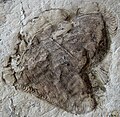Dickinsonia is a genus of extinct organism, most likely an animal, that lived during the late Ediacaran period in what is now Australia, China, Russia...
33 KB (3,072 words) - 16:46, 13 July 2024
Bhimbetka rock shelters (section "Dickinsonia fossils")
caves showing a man dancing and holding a trident-like staff Fossils of Dickinsonia tenuis, an early animal from the Ediacaran Period, were reported from...
25 KB (2,679 words) - 12:27, 8 June 2024
phylum was established by Mikhail A. Fedonkin in 1985 for such animals as Dickinsonia, Vendia, Cephalonega, Praecambridium and currently many other Proarticulata...
18 KB (1,467 words) - 01:01, 5 May 2024
animals, but the discovery of the animal lipid cholesterol in fossils of Dickinsonia establishes their nature. Animals are thought to have originated under...
125 KB (11,194 words) - 22:57, 23 August 2024
confirmed that one of the period's most-prominent and iconic fossils, Dickinsonia, included cholesterol, suggesting affinities to animals, fungi, or red...
105 KB (11,023 words) - 10:04, 16 August 2024
phyla such as Proarticulata (bilaterians with simple articulation, e.g. Dickinsonia and Spriggina), Petalonamae (sea pen-like animals, e.g. Charnia), Aspidella...
37 KB (3,650 words) - 05:46, 16 July 2024
Shale Chengjiang Sirius Passet Doushantuo Key organisms Ediacaran biota Dickinsonia Kimberella Kimberichnus Vernanimalcula Burgess-type Marrella Radiodonts...
85 KB (9,045 words) - 17:35, 23 August 2024
Precambrian body plans (section Dickinsonia)
the fossils that Charnia must have lived around 565 million years ago. Dickinsonia fossils are another notable fossil from the Ediacaran period, found in...
36 KB (4,539 words) - 02:53, 25 December 2023
genera Dickinsonia and probably Windermeria. Phyllozoon is associated with this family, and is thought to represent ichnofossils of Dickinsonia. Harrington...
1 KB (79 words) - 07:42, 29 October 2021
earliest animals may belong to the genus Dickinsonia, 571 million to 539 million years ago. Individual Dickinsonia typically resemble a bilaterally symmetrical...
63 KB (6,561 words) - 10:43, 23 June 2024
of Dickinsonia cast doubt on this identification, as these sterols are today associated only with animals. These researchers suggest that Dickinsonia and...
35 KB (3,884 words) - 19:56, 26 August 2024
Dickinsonia costata, an Ediacaran organism of unknown affinity, with a quilted appearance...
134 KB (15,430 words) - 19:06, 17 August 2024
and digested with the ventral (abdominal) surface. Dickinsonia menneri Dickinsonia tenuis Dickinsonia costata Windermeria Paleontology portal Seilacher...
2 KB (200 words) - 10:49, 15 February 2024
and spores. It has also been claimed that Ediacaran fossils including Dickinsonia, were lichens, although this claim is controversial. Endosymbiotic Glomeromycota...
130 KB (14,225 words) - 16:44, 20 August 2024
to Labrador", regional anthem Dickinson College's alma mater, "Noble Dickinsonia," with words written by Horatio Collins King. The College of the Holy...
13 KB (766 words) - 13:57, 20 August 2024
Dickinsonia, an enigmatic quilted organism with glide symmetry which may have been an early animal...
9 KB (844 words) - 12:09, 30 March 2024
Shale Chengjiang Sirius Passet Doushantuo Key organisms Ediacaran biota Dickinsonia Kimberella Kimberichnus Vernanimalcula Burgess-type Marrella Radiodonts...
31 KB (3,059 words) - 16:28, 12 June 2024
because of its morphological similarity with the iconic Ediacaran fossil Dickinsonia, and may have been a late surviving vendobiont. Rutgersella truexi is...
2 KB (172 words) - 09:40, 22 March 2024
mechanical inflation for "pneu" structures in Ediacaran biota fossils such as Dickinsonia. Günter P. Wagner argued for developmental bias, structural constraints...
24 KB (2,349 words) - 06:42, 7 August 2024
often found together with other species from the Ediacara biota, like Dickinsonia, Yorgia, Kimberella, Brachina, Parvancorina, Tribrachidium and others...
5 KB (467 words) - 21:32, 5 April 2024
many soft-jellied creatures shaped like bags, disks, or quilts (like Dickinsonia). Simple trace fossils of possible worm-like Trichophycus, etc.Taconic...
172 KB (9,499 words) - 20:32, 18 August 2024
Dickinsonia, an organism of the Ediacaran Period that precedes the Cambrian, whose affinity is still unknown....
9 KB (976 words) - 05:46, 26 October 2022
Dickinsonia costata, an Ediacaran organism of unknown affinity, with a quilted appearance...
100 KB (12,086 words) - 08:44, 22 August 2024
Dickinsonia costata from the Ediacaran biota, 635–542 Ma, a possible early member of Animalia....
87 KB (3,541 words) - 11:09, 24 August 2024
Upper Vindhyan rocks. A recent claim of the iconic Ediacaran fossil "Dickinsonia" located in the Upper Bhander (Retallack et al., 2021) required an Ediacaran...
23 KB (2,998 words) - 12:59, 8 August 2024
animal fossils may belong to the genus Dickinsonia, 571 million to 541 million years ago. Individual Dickinsonia typically resemble a bilaterally symmetrical...
304 KB (29,027 words) - 19:28, 21 August 2024
more in common with Dickinsonia brachina. Gehling (2006) noted that there is 'no evidence that Praecambridium is a juvenile Dickinsonia, Spriggina or Marywadea...
7 KB (648 words) - 21:55, 28 March 2024
mineralized tubes that some secreted. Some Ediacaran fossils such as Dickinsonia in some ways resemble polychaetes, but the similarities are too vague...
88 KB (9,008 words) - 20:26, 26 August 2024
although the Ediacaran biota (Precambrian, 550 million years ago) organism Dickinsonia appears somewhat similar to placozoans. Knaust (2021) reported preservation...
56 KB (5,788 words) - 01:17, 20 August 2024


























